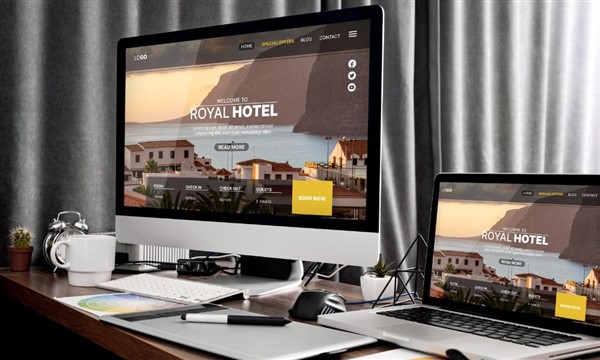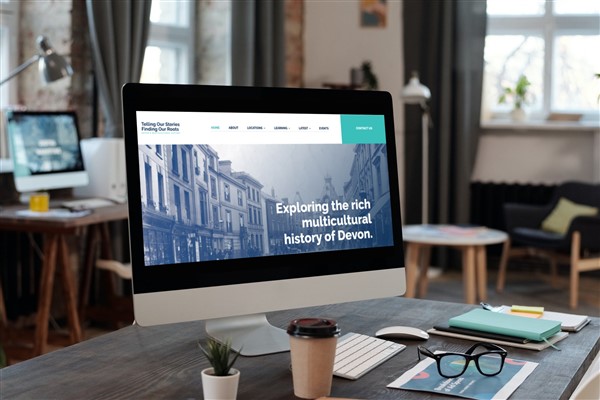Best Art Portfolio Websites British Columbia Canada
Creating an online presence is crucial for artists in today’s digital age. The Best Art Portfolio Websites British Columbia Canada can significantly enhance an artist’s career by providing a platform to showcase their work to a global audience. This article explores the essential aspects of building an effective art portfolio website, highlighting platforms and strategies tailored for artists in British Columbia, Canada.
Why You Need One of the Best Art Portfolio Websites British Columbia Canada

An online portfolio is more than just a website; it’s a dynamic representation of your artistic identity. Moreover, it acts as a central hub for potential clients, galleries, and collaborators. It allows you to control your narrative and present your work in the best possible light. Consider it your 24/7 online gallery, accessible to anyone, anywhere.
Think of an artist based in Vancouver, seeking representation from a gallery in Gastown. A well-designed portfolio website allows the gallery owner to quickly assess the artist’s style, quality, and consistency without the need for an initial physical meeting. Therefore, a professional online portfolio is an invaluable asset.
Furthermore, a strong online presence builds credibility and demonstrates your commitment to your craft. It can also lead to unexpected opportunities, such as commissions, collaborations, and exhibitions. Don’t underestimate the power of a thoughtfully crafted online portfolio.
Benefits of a Strong Online Art Portfolio
- Increased Visibility: Reach a global audience beyond British Columbia.
- Professional Credibility: Showcase your work in a polished and professional manner.
- Networking Opportunities: Connect with galleries, collectors, and fellow artists.
- Sales and Commissions: Facilitate direct sales and secure commissioned projects.
- Career Advancement: Enhance your reputation and open doors to new opportunities.
Key Features of the Best Art Portfolio Websites British Columbia Canada
What makes a truly outstanding art portfolio website? It’s not just about aesthetics; it’s about functionality, user experience, and effective communication. The best art portfolio websites prioritize showcasing the artwork while providing a seamless and engaging experience for visitors. Therefore, understanding these key features is essential for creating a successful online portfolio.
Consider the user experience from the perspective of a potential buyer or gallery owner. They want to quickly and easily find the information they need, such as your contact details, artist statement, and pricing (if applicable). A cluttered or confusing website will deter visitors and potentially cost you opportunities. Moreover, mobile-friendliness is crucial, as many people will be viewing your portfolio on their smartphones or tablets.
Furthermore, a well-structured website with clear navigation and high-quality images is paramount. Your artwork should be the star of the show, so avoid distracting design elements. Also, consider incorporating a blog or news section to share updates on your work, exhibitions, and inspirations. This keeps your website fresh and engaging for returning visitors.

Essential Elements for an Effective Art Portfolio
- High-Quality Images: Professionally photographed or scanned images of your artwork are non-negotiable.
- Clear Navigation: Easy-to-use menu and intuitive website structure.
- Artist Statement: A compelling and concise statement about your artistic vision and process.
- Biography: Information about your background, education, and experience.
- Contact Information: Prominent display of your email address and phone number.
- Mobile Responsiveness: Website design that adapts seamlessly to different screen sizes.
- Blog/News Section: Regular updates on your work, exhibitions, and other news.
- Social Media Integration: Links to your social media profiles.
- SEO Optimization: Ensure your website is easily discoverable through search engines.
Top Platforms for Building the Best Art Portfolio Websites British Columbia Canada
Several platforms cater specifically to artists looking to create online portfolios. Each platform offers different features, pricing plans, and levels of customization. Therefore, choosing the right platform depends on your technical skills, budget, and specific needs. We will explore some of the most popular and effective options for artists in British Columbia.
For artists who prefer a drag-and-drop interface and ease of use, platforms like Wix and Squarespace are excellent choices. They offer a wide range of templates specifically designed for artists and photographers. However, for those who desire more control over their website’s design and functionality, WordPress is a powerful and versatile option. It requires more technical knowledge but offers unparalleled customization possibilities. Moreover, specialized platforms like ArtStation and Behance are great for showcasing your work within a community of artists and designers.
Ultimately, the best platform is the one that allows you to create a website that effectively showcases your artwork and meets your specific needs. Consider trying out free trials or demos before committing to a particular platform. Also, don’t be afraid to seek help from a web designer or developer if you need assistance.
Platform Comparison for Art Portfolios
- WordPress: Highly customizable, requires technical knowledge, wide range of plugins and themes.
- Wix: Easy to use, drag-and-drop interface, limited customization compared to WordPress.
- Squarespace: User-friendly, visually appealing templates, all-in-one platform.
- ArtStation: Specifically for artists, community-focused, great for showcasing digital art.
- Behance: Part of Adobe Creative Cloud, ideal for showcasing design and creative projects.
SEO Strategies for Art Portfolio Websites in British Columbia
Having a beautiful website is only half the battle. You also need to ensure that potential clients and collaborators can find your website through search engines. This is where Search Engine Optimization (SEO) comes in. SEO involves optimizing your website to rank higher in search engine results pages (SERPs) for relevant keywords. Therefore, implementing effective SEO strategies is crucial for driving traffic to your art portfolio website.
Start by identifying the keywords that potential clients might use when searching for artists in British Columbia. These could include terms like “Vancouver artist,” “BC painter,” “Canadian sculptor,” or specific styles like “abstract art Vancouver.” Incorporate these keywords naturally into your website’s content, including your page titles, headings, image alt tags, and artist statement. Moreover, build high-quality backlinks from other websites in the art community, such as galleries, art blogs, and online art directories.
Furthermore, ensure your website is mobile-friendly and loads quickly. Google prioritizes websites that offer a good user experience. Also, consider using a content delivery network (CDN) to improve your website’s loading speed. Finally, regularly update your website with fresh content, such as blog posts about your work or upcoming exhibitions. This signals to search engines that your website is active and relevant.
Effective SEO Tactics for Artists
- Keyword Research: Identify relevant keywords that potential clients are searching for.
- On-Page Optimization: Incorporate keywords into your page titles, headings, and content.
- Image Alt Tags: Use descriptive alt tags for all images on your website.
- Backlink Building: Obtain high-quality backlinks from other websites in the art community.
- Mobile Optimization: Ensure your website is mobile-friendly and responsive.
- Website Speed: Optimize your website for fast loading speeds.
- Content Marketing: Regularly update your website with fresh content.
- Local SEO: Optimize your website for local search results (e.g., “Vancouver artist”).
Showcasing Your Art: Tips for Visual Presentation
Your artwork is the most important element of your portfolio website. Therefore, it’s crucial to present it in the best possible light. High-quality images are non-negotiable. Invest in professional photography or scanning to ensure your artwork is accurately represented. Moreover, consider the order in which you present your work. Start with your strongest pieces to make a lasting first impression.
Use a consistent style for your images, such as a uniform background and lighting. This creates a cohesive and professional look. Also, provide detailed information about each artwork, including the title, medium, dimensions, and year created. Consider adding a short description or story behind each piece to engage viewers. Furthermore, use a clean and minimalist design that doesn’t distract from your artwork.
Finally, consider the user experience. Make it easy for visitors to zoom in and view your artwork in detail. Also, ensure your website is mobile-friendly, as many people will be viewing your portfolio on their smartphones or tablets. A well-presented online portfolio can significantly enhance your reputation and attract potential clients and collaborators.

Best Practices for Visual Presentation
- High-Resolution Images: Use professionally photographed or scanned images.
- Consistent Style: Maintain a uniform background and lighting for all images.
- Detailed Information: Provide the title, medium, dimensions, and year created for each artwork.
- Compelling Descriptions: Add a short description or story behind each piece.
- Clean Design: Use a minimalist design that doesn’t distract from your artwork.
- Zoom Functionality: Allow visitors to zoom in and view your artwork in detail.
- Mobile Optimization: Ensure your website is mobile-friendly and responsive.
Promoting Your Art Portfolio Website in British Columbia
Once you’ve created your art portfolio website, you need to promote it to reach your target audience. Social media is a powerful tool for promoting your work and connecting with potential clients and collaborators. Share your artwork on platforms like Instagram, Facebook, and Twitter. Moreover, engage with other artists and art enthusiasts in the British Columbia community.
Consider participating in local art events and exhibitions. This is a great way to network with other artists and promote your website in person. Also, reach out to local galleries and art blogs to see if they would be interested in featuring your work. Furthermore, consider running online advertising campaigns to target potential clients in British Columbia. Platforms like Google Ads and Facebook Ads allow you to target specific demographics and interests.
Finally, don’t forget the power of word-of-mouth marketing. Tell your friends, family, and colleagues about your website. The more people who know about your work, the more opportunities will come your way. Promoting your art portfolio website is an ongoing process, so be patient and persistent.
Effective Promotion Strategies for Artists
- Social Media Marketing: Share your artwork on platforms like Instagram, Facebook, and Twitter.
- Local Art Events: Participate in local art events and exhibitions.
- Gallery Outreach: Reach out to local galleries to see if they would be interested in featuring your work.
- Art Blog Submissions: Submit your work to local art blogs and online magazines.
- Online Advertising: Run online advertising campaigns to target potential clients.
- Email Marketing: Build an email list and send out regular newsletters to your subscribers.
- Word-of-Mouth Marketing: Tell your friends, family, and colleagues about your website.
FAQs About Best Art Portfolio Websites British Columbia Canada
Here are some frequently asked questions about creating and managing art portfolio websites in British Columbia, Canada. These FAQs address common concerns and provide practical advice for artists looking to establish a strong online presence.
Q: How much does it cost to build an art portfolio website?
A: The cost of building an art portfolio website varies depending on the platform you choose and the level of customization you require. DIY platforms like Wix and Squarespace offer affordable monthly plans, while hiring a professional web designer can cost several thousand dollars. WordPress falls somewhere in between, as you’ll need to pay for hosting and a domain name, but you can use free themes and plugins to keep costs down. Consider your budget and technical skills when making your decision. Moreover, remember to factor in ongoing costs such as domain registration, hosting, and website maintenance.
Q: What should I include in my artist statement?
A: Your artist statement should be a concise and compelling description of your artistic vision, process, and inspirations. It should explain what you’re trying to achieve with your art and why you create it. Avoid jargon and use clear, accessible language. Also, tailor your artist statement to your specific audience. What do you want them to take away from your work? Moreover, keep your artist statement updated as your work evolves.
Q: How often should I update my art portfolio website?
A: You should update your art portfolio website regularly to keep it fresh and engaging for visitors. Add new artwork as you create it, and update your biography and artist statement as needed. Consider adding a blog or news section to share updates on your work, exhibitions, and other news. Moreover, regularly check your website for broken links and other errors. A well-maintained website signals to potential clients that you’re professional and committed to your craft.
Q: How important is mobile optimization for an art portfolio website?
A: Mobile optimization is crucial for an art portfolio website. Many people will be viewing your portfolio on their smartphones or tablets. If your website isn’t mobile-friendly, it will be difficult to navigate and view your artwork. This can lead to a poor user experience and potentially cost you opportunities. Therefore, ensure your website is responsive and adapts seamlessly to different screen sizes. Most website builders offer mobile-responsive templates, but it’s important to test your website on different devices to ensure it looks and functions correctly.
Q: How can I improve the SEO of my art portfolio website?
A: You can improve the SEO of your art portfolio website by implementing several strategies. Start by identifying relevant keywords that potential clients are searching for. Incorporate these keywords naturally into your website’s content, including your page titles, headings, and image alt tags. Build high-quality backlinks from other websites in the art community. Ensure your website is mobile-friendly and loads quickly. Regularly update your website with fresh content. Moreover, consider using a content delivery network (CDN) to improve your website’s loading speed.
Conclusion: Creating Your Best Art Portfolio Websites British Columbia Canada
Creating one of the Best Art Portfolio Websites British Columbia Canada requires careful planning, attention to detail, and a commitment to showcasing your work in the best possible light. By following the tips and strategies outlined in this article, you can create an online portfolio that effectively promotes your art and helps you achieve your career goals. Remember to focus on high-quality images, clear navigation, compelling content, and effective SEO. Moreover, be patient and persistent. Building a successful online presence takes time and effort. However, the rewards are well worth it. Finally, consider reaching out for professional help with website design or contact us for assistance.

